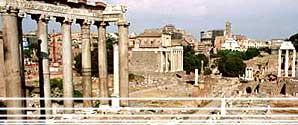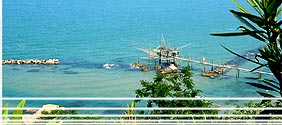 |
|
 |
City
of Rome - Italy
CITY OF ROME
Every year thousands of tourists come and visit
the charming city of Rome because it is unique
in the world thanks to its glorious history,
the beautiful Città del Vaticano (Vatican
City) and its several magnificent monuments
such as:
-
Castel Sant'Angelo (St
Angelo Castle);
-
the Colosseo (the Colosseum);
-
the Pantheon;
-
the Altare della Patria
(the Altar of Homeland).
The remains of the Foro Romano
(Roman Forum) and of the Palatino bear witness
to the city's heroic past time. In addition the
well-known squares and beautiful fountains, the
sumptuous baroque churches and noble palaces,
the masterpieces by artists such as Michelangelo,
Bernini, Raffaello, Caravaggio and Borromini make
the Eternal City one of the most visited capital
cities in the world.
|
 |
| |
- Piazza del Popolo (People Square)
It was built by Valadier at the beginning
of the nineteenth century. The square is
made up of:
-
the Flaminio Obelisk
(or Egyptian Obelisk), dating back to
the days of Ramesse II (1200 B.C.).
Emperor Augusto ordered to carry it
to Rome and to put it together with
four fountain basins and some marble
lions at Circo Massimo. The Flaminio
Obelisk stands in the middle of Piazza
del Popolo;
-
two twin churches:
St Maria in Montesanto on the right
and St Maria dei Miracoli (St Mary of
the Miracles) on the left, divided by
Via del Corso. They are both on the
south side of the square;
-
the Porta del Popolo
and the Church of St Maria del Popolo,
which was built by order of Pope Pasquale
II in 1099 and restored in Renaissance
style during the XV century, are on
the north side of the square.
Inside the Church you can see interesting
works of art: the Cappella della Rovere
(Rovere Chapel), frescoed by Pinturicchio;
the Cappella Cybo (Cybo Chapel), built
by Carlo Fontana; the Cappella Maggiore
(Major Chapel)with the paintings of
the Byzantine-looking Madonna del Popolo
and "The Coronation of the Virgin",
a fresco by Pinturicchio; the Cappella
Cerasi (Cerasi Chapel), where you can
see the popular works by Caravaggio
"The Crucifixion of St Peter"
and "The Conversion of St Paul";
the Cappella Chigi (Chigi Chapel) with
the precious tabernacle by Andrea Bregno
located in the sacristy and the decorations
by Raffaello, the artist who made the
dome's mosaics too.
|
|
 |
|
 |
|
(Piazza di Spagna (Spanish
Square))
Rome, 100 mt |
 |
|
|
- Piazza di Spagna (Spanish Square)
The Church of Trinità dei Monti dominates
Piazza di Spagna, that is without any doubt
one of the most well-known and picturesque
places in Rome. It has been the heart of
the city's cultural and touristic life since
the sixteenth century.
The baroque Spanish Steps are made up of
12 travertin flights of steps. They are
often exploited for important events.
At the foot of the Spanish Steps you can
see the beautiful "Fontana della Barcaccia",
made by Pietro Bernini in 1629 and commissioned
by Pope Urbano VIII Barberini. The fountain
was built as a memorial to the overflow
of the River Tiber, whose waters reached
the foot of Pincio. That is the reason why
the fountain is boat-shaped: the stem is
the same as the stern; on the external side
of the boat you can see Urbano VIII's coats
of arms whereas on both sides there are
two openings spilling out water into the
fountain below.
|
|
 |
|
 |
|
(Piazza Navona (Navona
Square))
Rome, 100 mt |
 |
|
|
- Piazza Navona (Navona Square)
Piazza Navona is one of the most crowded
places in Rome: by day people get there
to see the marvellous works of art decorating
the square; by night it becomes a meeting
place thanks to its many restaurants,
haunts and clubs. Without any doubt it
is one of the most beautiful and popular
squares: there you can see masterpieces
by artists such as Bernini and Borromini.
Three works of art decorate the square:
-
the Fontana dei Fiumi
(The Fountain of the Rivers): it was
built in 1651 by Gian Lorenzo Bernini.
It is in the middle of the square. It
is formed by four statues symbolizing
the Rivers Danubio, Gange, Nilo and
Rio della Plata. They represent the
four continents which were known at
that time. An Egyptian obelisk stands
in the middle of the fountain: on its
top there is a dove with an olive branch,
a symbol of the Pamphili family, that
commissioned the work.
-
the Fontana del Moro
(The Fountain of Moorish): it is on
the southern side of the square. It
is so-called because of a statue portraying
a Moorish fighting against a dolphin.
-
the Fontana del Nettuno
(The Fountain of God Neptune): it is
on the northern side of the square.
You can see a statue portraying the
God Neptune fighting against an octopus.
|
|
 |
|
 |
|
(Fontana di Trevi (Trevi
Fountain))
Rome, 100 mt |
 |
|
| -
Fontana di Trevi (Trevi Fountain)
The fountain, which is a mixture of architecture
and sculpture, is the most popular and scenographic
in Rome. Pope Clement XIII unveiled the
fountain, 26 metres tall and 20 metres wide,
in 1762.
On the upper side of the fountain you can
see Clement XIII's coat of arms; four statues,
symbolizing the four seasons, stand on the
banisters. A statue portraying the God Ocean
on a cart drawn by two horses stands in
a central niche. One horse is quiet whereas
the other horse is upset: they represent
the conditions of the sea, which is symbolized
by the wide fountain. On both sides there
are two statues portraying the God Salubrity,
on the right, and the God Abundance, on
the left. Above you can see the statue of
the Virgin showing the soldiers the fountain
and the statue of Agrippa approving the
fountain's plan.
On the left of the fountain there is the
so-called "Fontana degli Innamorati"
(Fountain of Lovers"): it is said that
lovers who drink that fountain's water will
be never unfaithful to each other.
|
|
 |
| |
| -
Vittoriano, Altare della Patria
The Altare della Patria or Vittoriano was
built to celebrate the first king of Italy.
It is the "tomba del Miliite Ignoto"
("the tomb of the Unknown Soldier),
with the corpse of an unknown soldier who
died during World War I. It is constantly
guarded by sentries.
The magnificent monument devoted to Vittorio
Emanuele was unveiled in 1911 but it was
finished only after twenty years. It was
necessary to pull down the Aracoeli Convent
and Paolo III ' s Tower in order to build
the Vittoriano. The monument, faced with
marble from Botticino, has a big flight
of steps flanked with two winged lions and
two bronze statues portraying the God Victory.
In the middle of the central complex you
can see a statue symbolizing the city of
Rome together with the statues of triumphal
Parades of Work and Patriotism. The bronze
statue of Vittorio Emanuele II, 12 metres
tall, dominates the central part of the
monument. You can also admire a magnificent
curved portico made up of sixteen columns
and the statues of the Italian regions.
The monument is enriched by two colossal
bronze quadriga with statues of the winged
God Victory.
The monument is also called Altare della
Patria (Altar of Homeland) because it symbolizes
the national unity. The monument contains
the Museo Sacrario delle Bandiere della
Marina Militare (The Museum of Flags of
the Military Navy) and the Museo Centrale
del Risorgimento (the Central Museum of
the Risorgimento).
|
|
|
|
|
 |
 |
| Beach
hotels |
| the most beautiful beaches
of Italy in the best hotels |
|
|
|


